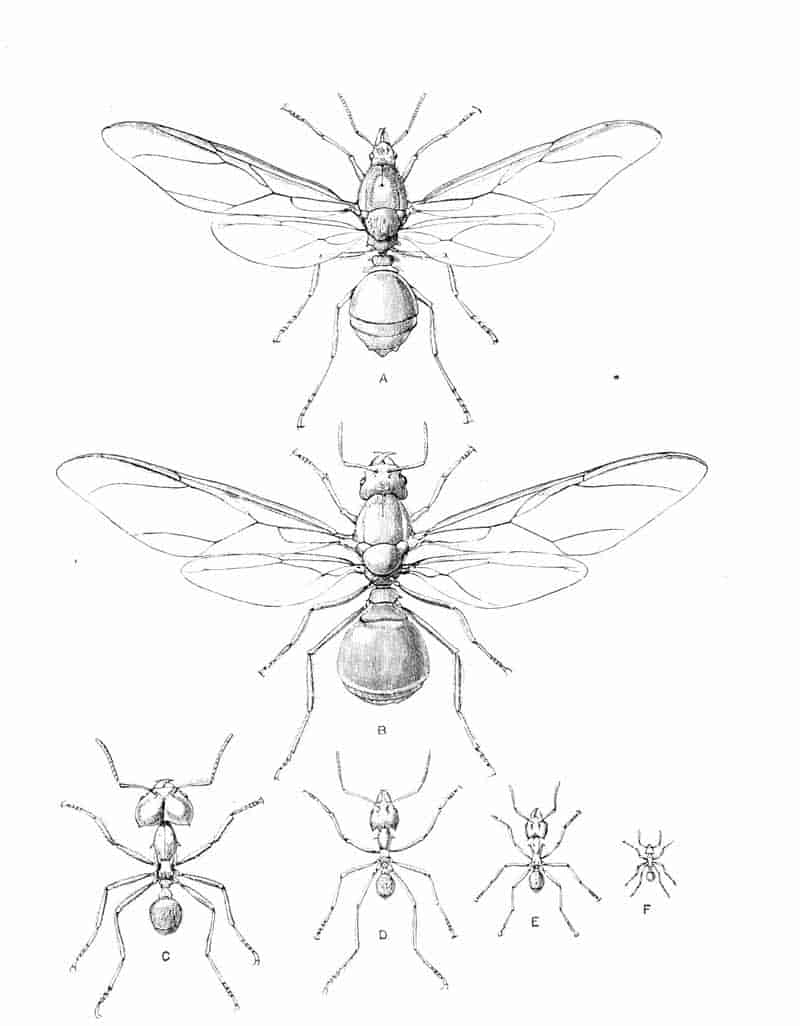Adult forms of Atta cephalotes, taken from a nest in Trinidad by Mr. J. H. Hart, 25th June 1895. A, male; B, winged female; C-F, various forms unwinged; C, so-called soldier; D, large worker; E, smaller worker; F, smallest worker or nurse. All equally magnified (one and half times).
Superregnum: Eukaryota
Cladus: Unikonta
Cladus: Opisthokonta
Cladus: Holozoa
Regnum: Animalia
Subregnum: Eumetazoa
Cladus: Bilateria
Cladus: Nephrozoa
Cladus: Protostomia
Cladus: Ecdysozoa
Cladus: Panarthropoda
Phylum: Arthropoda
Subphylum: Hexapoda
Classis: Insecta
Cladus: Dicondylia
Subclassis: Pterygota
Cladus: Metapterygota
Infraclassis: Neoptera
Cladus: Eumetabola
Cladus: Endopterygota
Superordo: Hymenopterida
Ordo: Hymenoptera
Subordo: Apocrita
Superfamilia: Formicoidea
Familia: Formicidae
Subfamilia: Myrmicinae
Tribus: Attini
Genus: Atta
Species: Atta cephalotes
Name
Atta cephalotes (Linnaeus, 1758)
Synonymy
Formica cephalotes Linnaeus
Formica fervens Drury
Formica grossa Fabricius
Formica migrator De Geer
Formica migratoria De Geer
Atta fervens (Drury)
Atta grossa (Fabricius)
Atta integrior Forel
Atta lutea Forel
Atta migratoria (De Geer)
Atta opaca Forel
Atta polita Emery
Atta visitatrix (Christ)
Vernacular names
English: Leaf-Cutter Ants
español: Zompopo
References
Linnaeus, C. 1758. Systema naturae. Regnum Animale. 10th ed. W. Engelmann, Lipsiae.
Atta cephalotes is a species of leafcutter ant in the tribe Attini (the fungus-growing ants). A single colony of ants can contain up to 5 million members, and each colony has one queen that can live more than 15 years. The colony comprises different castes, known as "task partitioning", and each caste has a different job to do.[2]
Taxonomy
The species is one of the earliest formally classified ants, first described by Swedish zoologist Carl Linnaeus in 1758 as Formica cephalotes in the 10th edition of Systema Naturae together with 16 other ant species, all of which he placed in the genus Formica.[3] It was later transferred to a new genus, Atta, along with five other species by Danish zoologist Johan Christian Fabricius in 1804.[4] In 1911, American entomologist William Morton Wheeler designated A. cephalotes as the type species of Atta.[5] It was also designated as the type species of Oecodoma, but the genus is now a synonym of Atta.[6]
Biology and behaviour
A special caste of workers manages the colony's rubbish dump. These ants are excluded from the rest of the colony. If any wander outside the dump, the other ants will kill them or force them back. Rubbish workers are often contaminated with disease and toxins, and live only half as long as their peers.[7]
Distribution and habitat
The species is widely distributed in the Neotropical region, from Mexico to Bolivia, with disjunct populations in Amazonas and north-eastern Brazil.[8]
Across the rainforest floor they typically occupy an area of approximately 20 square feet. They live in nests that can be as deep as 7 metres that they have carefully positioned so that a breeze can rid the nest of the dangerous levels of CO2 given off by the fungus they farm and eat.[9]
References
"Species: Atta cephalotes". AntWeb. 2010-06-30. Retrieved 2010-08-20.
Wilson, Edward O. (December 1983). "Caste and division of labor in leaf-cutter ants (Hymenoptera: Formicidae: Atta): III. Ergonomic resiliency in foraging by A. cephalotes". Behavioral Ecology and Sociobiology. 14 (1): 47–54. doi:10.1007/BF00366655. ISSN 0340-5443. S2CID 23048898.
Linnaeus, C. (1758). Systema naturae per regna tria naturae, secundum classes, ordines, genera, species, cum characteribus, differentiis, synonymis, locis. Tomus I (10th ed.). Holmiae. (Laurentii Salvii). pp. 579–582.
Fabricius, J. C. 1804. Systema Piezatorum secundum ordines, genera, species, adjectis synonymis, locis, observationibus, descriptionibus. Brunswick: C. Reichard, p. 421
Wheeler, W. M. (1911). "A list of the type species of the genera and subgenera of Formicidae". Annals of the New York Academy of Sciences. 21: 157–175. doi:10.1111/j.1749-6632.1911.tb56932.x. S2CID 85430772.
Swainson, W.; Shuckard, W.E. (1840). On the history and natural arrangement of insects. Vol. 104. London, UK: Longman, Brown, Green & Longman's. p. 174. doi:10.5962/bhl.title.32786. OCLC 4329243.
"Treated like garbage". New Scientist. 2001-01-20. Retrieved 2015-08-17.
Corrêa, M.M.; Bieber, A.G.D.; Wirth, R.; Leal, I.R. (2005). "Occurrence of Atta cephalotes (L.) (Hymenoptera: Formicidae) in Alagoas, Northeastern Brazil". Neotropical Entomology. 34 (4): 695–698. doi:10.1590/S1519-566X2005000400023.
Sousa, Kátia K. A.; Camargo, Roberto S.; Caldato, Nadia; Farias, Adriano P.; Matos, Carlos A. O.; Zanuncio, José C.; Santos, Isabel C. L.; Forti, Luiz C. (December 2021). "Carbon dioxide levels in initial nests of the leaf-cutting ant Atta sexdens (Hymenoptera: Formicidae)". Scientific Reports. 11 (1): 20562. doi:10.1038/s41598-021-00099-8. ISSN 2045-2322. PMC 8523712. PMID 34663831.
Retrieved from "http://en.wikipedia.org/"
All text is available under the terms of the GNU Free Documentation License


